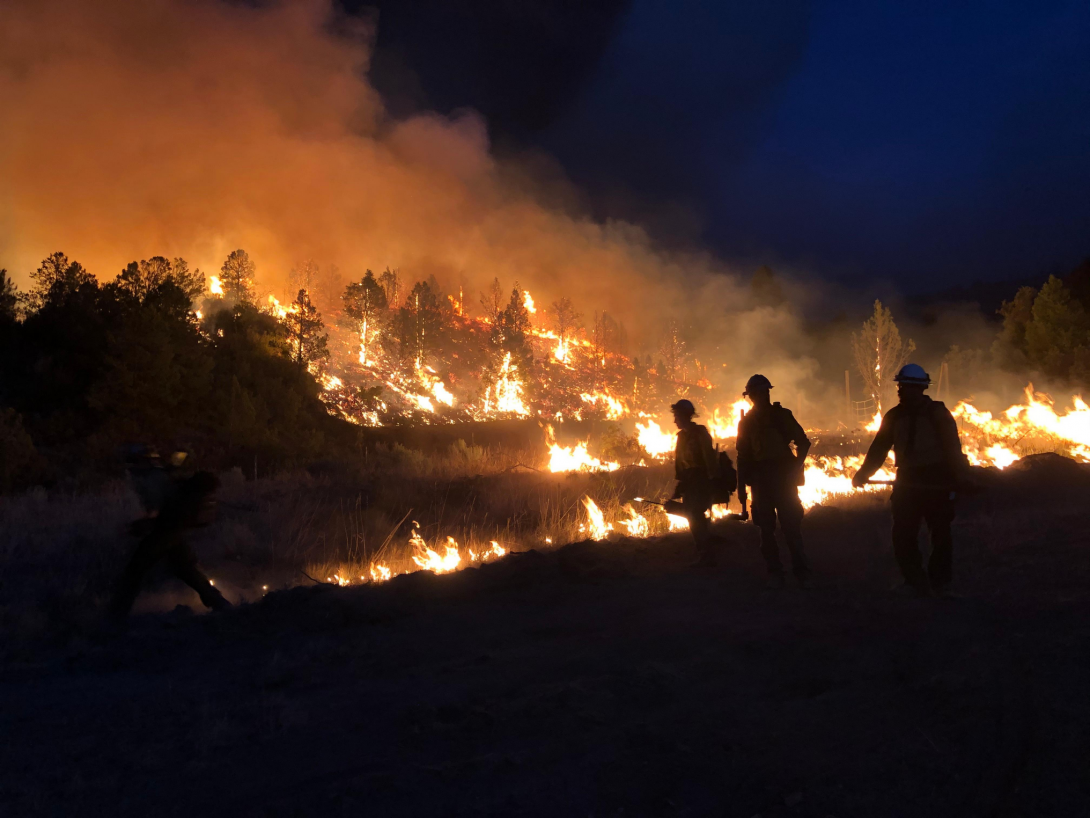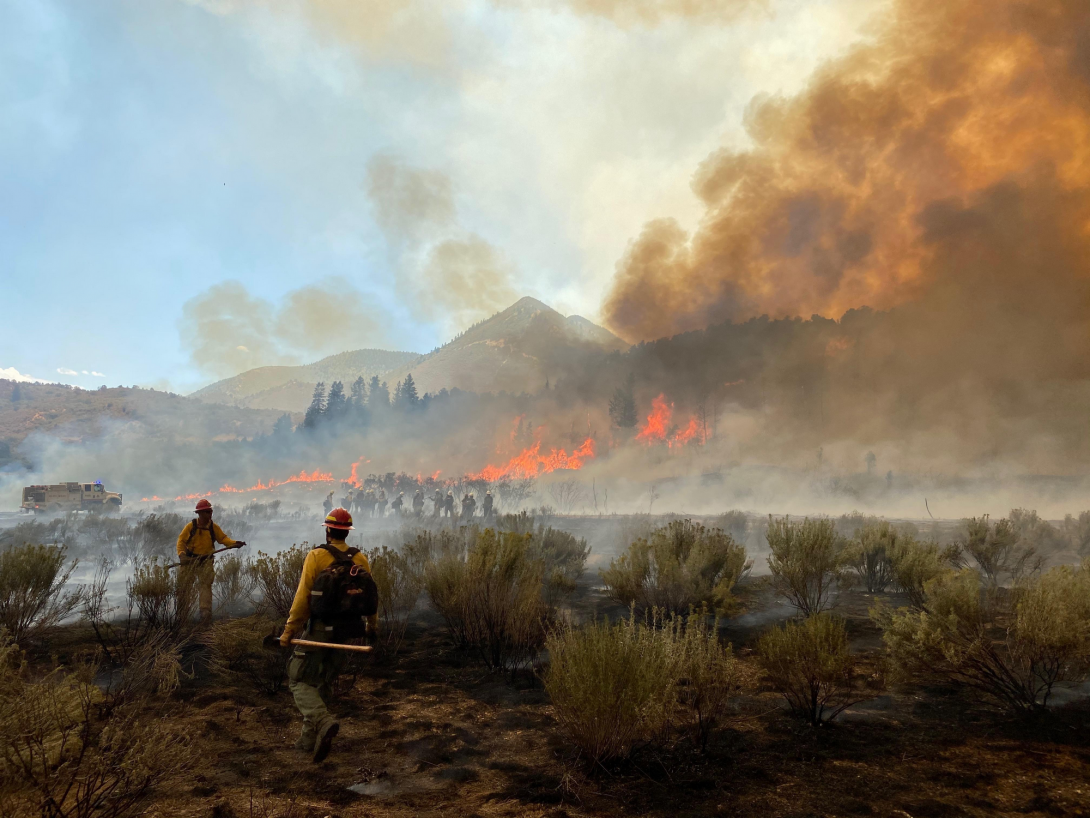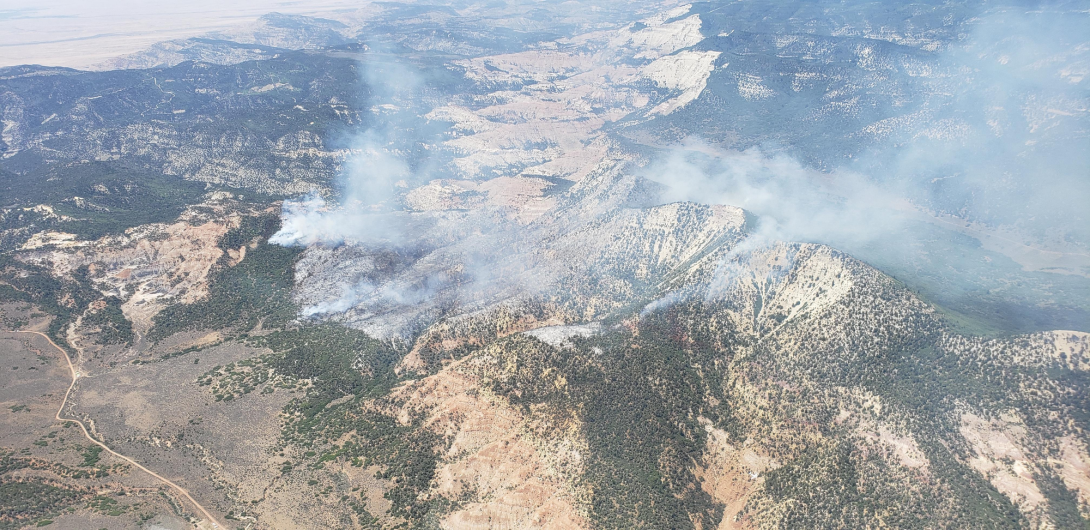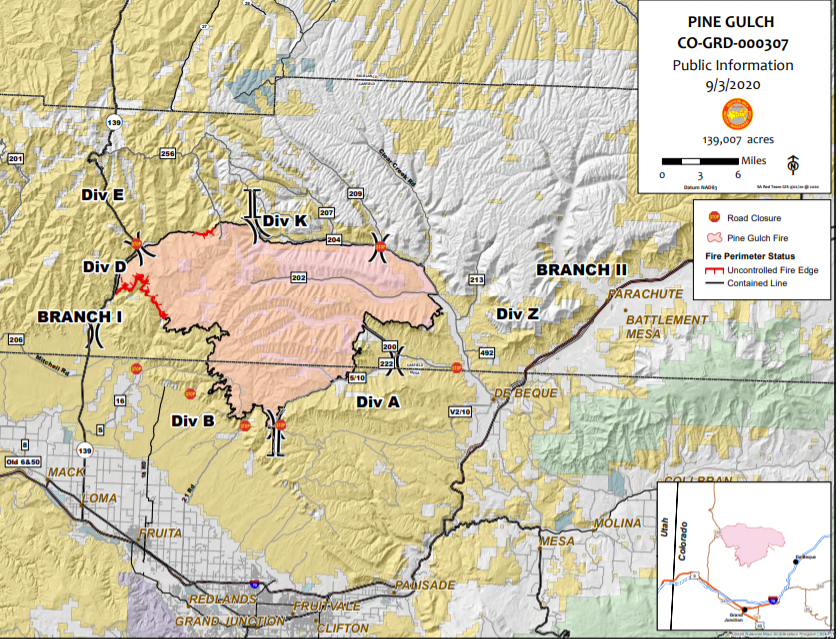Pine Gulch Fire
Full Article
The Pine Gulch Fire was ignited by a lightning strike on July 31, 2020, about eighteen miles north of Grand Junction in Garfield and Mesa Counties. Over the next month, the fire grew to encompass more than 139,000 acres, making it the third-largest wildfire in Colorado history.
The Pine Gulch Fire burned simultaneously with several other fires across the state as part of a record-breaking 2020 wildfire season in the United States. For a time, the Pine Gulch Fire was the largest in Colorado history, until the Cameron Peak Fire displaced it in September. Fire conditions were influenced by high temperatures, low humidity, and high winds amid a statewide drought proclaimed in early August. Most structural damage was avoided, and while the Pine Gulch Fire did not directly threaten communities, it forced hundreds to evacuate, caused toxic air quality in Grand Junction, and cost $34 million to fight.
Origins
Grand Junction saw sweltering heat throughout the summer of 2020, with multiple days above 100 degrees Fahrenheit. Temperatures in the city reached 101 degrees on July 31, the day the Pine Gulch Fire was ignited by a lightning strike in the dried-out wilderness above the Book Cliffs to the north.
Rapid Spread
Ten days later, the fire had grown to more than 29,000 acres and forced evacuations as it jumped across county roads near Horse Mountain, about a dozen miles west of De Beque and Interstate 70. High winds and hot, dry weather kept the blaze spreading, even as hundreds of firefighters joined the effort to stop it. By August 13, it had more than doubled in size, growing to more than 68,000 acres—about 100 square miles. By August 17, more than 750 people were battling the blaze, including bulldozer and structure-protection crews as well as rotary and fixed-wing aircraft.
Thanks to these efforts, crews had the Pine Gulch Fire at about 7 percent containment by August 18. But then the fire exploded with wind gusts during an overnight thunderstorm, reaching 125,000 acres by the following day. Eventually pushing across some 139,000 acres, it eclipsed the Hayman Fire as the state’s largest to that point. Evacuation orders were extended west all the way to the Utah border. For at least five days, smoke from the fire caused particulate levels to rise to unhealthy and unprecedented amounts in and around Grand Junction.
On August 20, with four large fires burning largely uncontained across the state, Governor Jared Polis activated the National Guard and issued a statewide fire ban for thirty days. The state got additional help from a federal Fire Management Assistance Grant that would reimburse Colorado for up to 75 percent of its firefighting costs.
Containment
Despite the big blowup the day before, crews reported on August 19 that “three-fourths of the fire” had been stopped. Containment still stood at a modest 7 percent, but this would steadily increase to 77 percent by August 28. One of the main reasons that crews were able to quickly increase containment of the Pine Gulch Fire was its fuel source: the sage-covered Book Cliffs did not take as well to burning as more heavily wooded parts of the Front Range (which would see terrifying runs by the Cameron Peak Fire later that year). In addition, the burn scar of the Hunter Canyon Fire, a smaller fire that had burned earlier in the season, helped keep the Pine Gulch Fire in check. Crews reached 81 percent containment with no new fire growth by September 1 and had the blaze fully contained by September 23.
Aftermath
As containment increased on the Pine Gulch Fire, the federal Burned Area Emergency Response team (BAER) moved in to assess vegetation and soil damage. Some 80 percent of the fire occurred on land managed by the federal Bureau of Land Management (BLM). Although many parts of the fire were considered a “high intensity” burn, the impact on soils was deemed “low to moderate.” Green grass and scrub oak sprouts were already coming up from the charred soil in some places, leading to an optimistic assessment of fire recovery.
Still, the BAER team confirmed that cattle ranchers in the area would be hard-pressed for some time, as many had licenses to graze in an area that was now devoid of vegetation. When vegetation does come back, officials from the BLM headquarters in Grand Junction note that grazing will need to be delayed for several seasons so cattle do not drive out deer and other grass-dependent species. This will allow for a more complete ecological recovery.
Legacy
The conditions that caused the Pine Gulch Fire’s rapid spread in mid-August 2020 will only become more common in the future, as Colorado’s climate continues to warm and long, severe droughts increase in frequency. This was even more evident when the Cameron Peak and East Troublesome Fires blew up to historic proportions on the Front Range later that fall—Colorado had never before experienced two record-breaking fires in one season, let alone three.
Even under favorable fire conditions, however, the Pine Gulch Fire also shows that fuel types matter. Sagebrush does not burn as readily as beetle-killed pine trees, a difference made painfully clear to crews who had far less success containing the Cameron Peak and East Troublesome Fires later in the year.
























